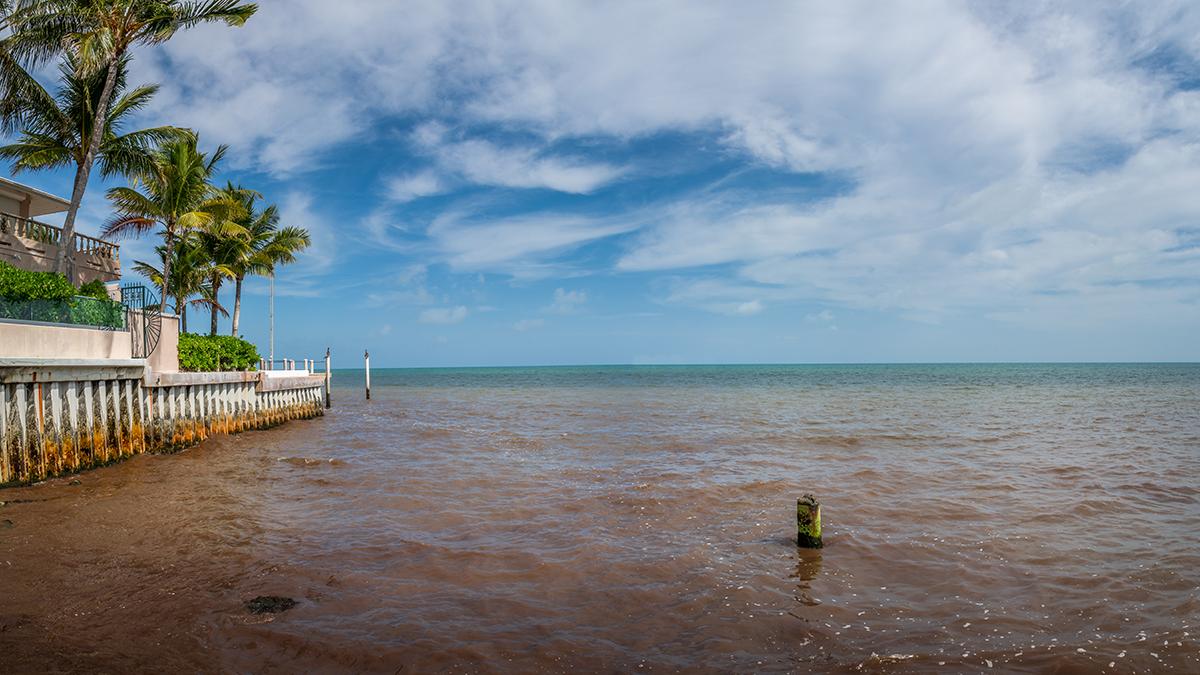
Red tide in the summer season, a harmful algal bloom phenomenon in Key West, Florida. (By Spartaq for AdobeStock)
Florida’s beaches attract millions of tourists each year, but harmful algal blooms known as red tide continue to threaten the state’s coastal waters, marine life, and economy.
Researchers at the FAMU-FSU College of Engineering are using artificial intelligence and satellite data to predict and prevent these toxic blooms.
$750,000 EPA Grant Supports Red Tide Prevention Research

The microscopic alga Karenia brevis (K. brevis) causes red tide blooms along Florida’s Gulf Coast. The U.S. Environmental Protection Agency has awarded $750,000 to FAMU-FSU College of Engineering for a five-year project to protect South Florida’s coast from harmful algal blooms.
Ebrahim Ahmadisharaf, an assistant professor at Florida State University, leads the project with Xiuming Sun, a postdoctoral researcher. Both work with the Resilient Infrastructure and Disaster Response (RIDER) Center and the Department of Civil & Environmental Engineering.
“In recent years, we have seen an alarming increase in the duration and severity of harmful algae blooms, resulting in tragic wildlife losses,” Ahmadisharaf explains. “We are determined to uncover the factors fueling these blooms so we can pave the way for effective prevention strategies.”
What Causes Red Tide Blooms
Ahmadisharaf points to several factors that contribute to harmful algal blooms. Severe storms like hurricanes stir up coastal waters and bring K. brevis closer to shore. Nutrient pollution from stormwater runoff, fertilizers, septic systems, and wastewater also plays a role.
“We are leveraging satellite remote sensing and sophisticated geospatial analyses to build a regional predictive tool,” Sun explains. “This will enhance our ability to monitor, predict, and ultimately mitigate these harmful blooms.”
The team is mapping areas along the South Florida Gulf coastline and estuaries where outbreaks are most likely. They’re using data from northern, central, and southern Florida.
Economic Impact of Red Tide
Red tide events cost Florida’s economy billions of dollars. In 2018, the southwest coast of Florida faced $2.7 billion in damages from red tide. Past blooms have killed wildlife and caused nearly $6.5 million in tourism losses in Pinellas and Manatee counties.
The Red Tide Task Force is working to address the problem, but Ahmadisharaf says more research is needed. “Despite previous studies, gaps remain in understanding the factors that influence algal blooms under varying conditions,” he states. “By enhancing our understanding, we can develop predictive models that safeguard our coastal ecosystems.”
Research Partners and Goals

The FAMU-FSU team is working with federal, state, and local agencies, NGOs and community partners. These partnerships help turn research data into practical solutions.
“By unlocking the mysteries of red tide, we have the potential for transformative impacts on the health of our coastal communities,” Ahmadisharaf asserts. “With improved prediction and early warning systems, we can develop environment-friendly strategies that address the root causes of blooms.”
The research combines civil engineering, environmental science, and computer modeling to tackle red tide. The team’s goal is to create early warning systems that help Florida communities prepare for and prevent harmful algal blooms.
Editor’s Note: This article was edited with a custom prompt for Claude Sonnet 4, an AI assistant created by Anthropic. The AI optimized the article for SEO discoverability, improved clarity, structure and readability while preserving the original reporting and factual content. All information and viewpoints remain those of the author and publication. This article was edited and fact-checked by college staff before being published. This disclosure is part of our commitment to transparency in our editorial process. Last edited: 09/29/2025.
RELATED ARTICLES
Civil Engineering Professor Receives National Water Resources Award for AI-Driven Algae Research
Engineering Researchers Reveal Harmful Blue-Green Algae Hotspots Across Florida’s Lakes
FSU Engineering Student Researches Sustainable Building Solutions Using Invasive Species
